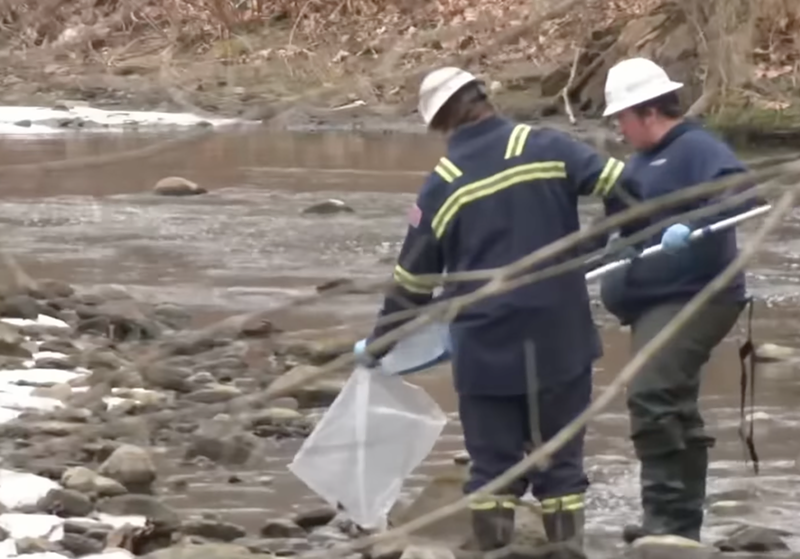
Screenshot: YouTube, CBS Pittsburgh
Crews clean up and inspect a waterway near East Palestine, Ohio, where a train derailed and caused a chemical leak that could affect cities along the Ohio River like Cincinnati.
The legal clerk whose investigation into a chemical leak in California spawned an Oscar-winning film is now eyeing Ohio with suspicion, and her focus could spell trouble for a railway sale in Cincinnati.
On Feb. 3, a freight train carrying hazardous materials derailed in East Palestine, Ohio, a village in a relatively rural area that is about 280 miles northeast of downtown Cincinnati and just miles from the Pennsylvania border. Of the more than 100 cars on the Norfolk Southern Railway train, about 50 had careened off the track and caused a fiery explosion, the rail operator said. The reason? About 20 of the cars were carrying toxic chemicals, the Associated Press reported.
That's what consumer advocate Erin Brockovich is concerned with, she said on Twitter on Feb. 11. Brockovich had built her reputation on building and winning the case against Pacific Gas & Electric Company, a utility company that, a court found, had contaminated the water near Hinkley, California, with a carcinogen. Through her employer, law firm Masry & Vititoe, Brockovich proved a connection between PG&E's actions and the illnesses that Hinkley residents had endured. Her investigation was the subject of the highly rated 2000 film Erin Brockovich, which won Julia Roberts an Academy Award for her role as Brockovich.
According to Brockovich, something similar to the fallout from the PG&E incident may happen in Ohio.
"I’m trying to gather information on this very serious situation in Ohio involving a train derailment with hazardous chemicals," Brockovich tweeted. "What I will say is this. Trust your eyes, ears and nose and get the hell out of there if your senses are telling you too [sic]."
Experts already have said that the chemical leaks – which authorities said included phosgene, hydrogen chloride and vinyl chloride and could cause life-threatening medical issues – from the train crash were dangerous. Fumes and smoke covered the town so severely that it warranted a week-long mandatory evacuation of thousands of residents, and East Palestine mayor Trent Conaway called a state of emergency, The Guardian reported. On Feb. 6, Ohio governor Mike DeWine ordered residents to leave their village.I’m trying to gather information on this very serious situation in Ohio involving a train derailment with hazardous chemicals.
— Erin Brockovich (@ErinBrockovich) February 11, 2023
What I will say is this. Trust your eyes, ears and nose and get the hell out of there if your senses are telling you too.
"This is a matter of life and death," DeWine said (many residents returned home around Feb. 11, according to pooled news reports).
Crews completed a controlled burn of the area and vented five rail cars containing vinyl chloride, which is used in industrial processes and is found in PVC plastics like those found at large hardware stores. Authorities continue to investigate the train derailment as well as the effects of the vented chemical on the air and water, CNN reported.
The trail had been traveling from Madison, Illinois, to Conway, Pennsylvania, Norfolk Southern said on Feb. 4.
How the train derailment affects Cincinnati
In November, Cincinnati mayor Aftab Pureval announced that after more than 140 years of exclusive city ownership, Cincinnati could sell the Cincinnati Southern Railway to Norfolk Southern for $1.6 billion to fund the city’s infrastructure maintenance needs.The 337-mile freight railway, which runs from Cincinnati to Chattanooga, is the only city-owned multi-state railway in the country. Over the years, Cincinnati has leased the line to rail operator Cincinnati, New Orleans and Texas Pacific Railway (CNO&TP), a wholly-owned subsidiary of Norfolk Southern. The first lease agreement with CNO&TP was signed in 1881 and has been renewed on a 25-year cycle ever since. The current lease agreement is set to expire in 2026, according to the city.
The city receives $25 million annually to lease the railway to Norfolk Southern, but under the proposed sale, Cincinnati would receive $1.6 billion for the "Building Our Future" trust fund. The trust would dole out no less than $25 million to the city each year after the sale
For the sale to occur, the state's legislature must vote to change some legal language allowing it, and the U.S. Surface Transportation Board must provide regulatory clearance. Cincinnati residents then will vote on the issue, likely in the fall.
But will Cincinnati residents approve the sale after the East Palestine incident? Authorities still are investigating the cause of the derailment, but newly released footage showed that the Norfolk Southern train had traveled at least 20 miles with an axel on fire, the Pittsburgh Post-Gazette reported.
Moreover, environmental experts are concerned about chemicals from the train seeping into the groundwater and flowing to cities along the Ohio River, causing longterm health and environmental problems. Via KDKA-TV in Pittsburgh, CBS News reported that hundreds of dead fish were found in waterways near East Palestine. Environmental Protection Agency officials were investigating well and drinking water.
Many Ohio residents aren't believing the EPA's claims that their water is safe, though, with people talking about dead or dying animals, sharing concern for cities downriver and likening the train derailment incident to the 1986 nuclear disaster in Chernobyl. One person deduced that when counting all of the counties near East Palestine alone, nearly 1.4 million people could be affected.The EPA claims well and groundwater are safe, but people are finding hundreds of dead fish and questioning that assessment. Video below: https://t.co/VGHDZQ13KX
— Laura Miers (@LauraMiers) February 9, 2023
In a memo to Pureval and members of Cincinnati City Council, city manager Sheryl Long said that Greater Cincinnati Water Works also is looking into how the chemicals may affect the water here.
"Hazardous materials teams from the Ohio and US EPAs responded quickly and took measures to contain contamination from these compounds, but low levels of butyl acrylate have been detected in samples of the Ohio River downstream of the incident, but currently far upstream of Cincinnati," Long wrote on Feb. 10.
Long said that GCWW is working with a variety of agencies to collect and analyze water samples.
"If this compound is detected near Cincinnati, GCWW can shut the river intakes for a period of time to avoid the compound altogether," Long said. "The Granular Activated Carbon (GAC) used in GCWW’s water treatment plant and other steps in the treatment process will remove the compound so no impact to the drinking water quality is expected."
Local, state and federal officials are continuing to investigate the incident.
Coming soon: CityBeat Daily newsletter. We’ll send you a handful of interesting Cincinnati stories every morning. Subscribe now to not miss a thing.
Follow us: Google News | NewsBreak | Reddit | Instagram | Facebook | Twitter






